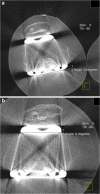Patient specific implants: scope for the future
- PMID: 24691710
- PMCID: PMC4092203
- DOI: 10.1007/s12178-014-9214-2
Patient specific implants: scope for the future
Abstract
"Patient Specific" technology introduced in last 5 years, slowly gained popularity but has currently plateaued. We have a number of studies on patient specific instruments where they have been compared with conventional jigs in total knee arthroplasty and reported to have no clear additional benefits. This review discusses their intraoperative and postoperative advantages/disadvantages and cost effectiveness and provides a synopsis in light of current literature. Patient specific implants are not freely available yet, and there is no scientific literature reporting on their use in clinical practice.
Figures

Similar articles
-
Patient-Specific Orthopaedic Implants.Orthop Surg. 2016 Nov;8(4):417-424. doi: 10.1111/os.12282. Orthop Surg. 2016. PMID: 28032697 Free PMC article. Review.
-
Computer-assisted hip and knee arthroplasty. Navigation and active robotic systems: an evidence-based analysis.Ont Health Technol Assess Ser. 2004;4(2):1-39. Epub 2004 Feb 1. Ont Health Technol Assess Ser. 2004. PMID: 23074452 Free PMC article.
-
Robotics in Total Knee Arthroplasty.J Knee Surg. 2019 Jul;32(7):600-606. doi: 10.1055/s-0039-1681053. Epub 2019 Mar 1. J Knee Surg. 2019. PMID: 30822790 Review.
-
Analysis of procedure-related costs and proposed benefits of using patient-specific approach in total knee arthroplasty.J Surg Orthop Adv. 2011 Summer;20(2):112-6. J Surg Orthop Adv. 2011. PMID: 21838072
-
Unicompartmental knee arthroplasty with use of novel patient-specific resurfacing implants and personalized jigs.J Bone Joint Surg Am. 2009 Feb;91 Suppl 1:69-76. doi: 10.2106/JBJS.H.01448. J Bone Joint Surg Am. 2009. PMID: 19182028
Cited by
-
Patient - implant dimension mismatch in total knee arthroplasty: Is it worth worrying? An Indian scenario.Indian J Orthop. 2016 Sep;50(5):512-517. doi: 10.4103/0019-5413.189618. Indian J Orthop. 2016. PMID: 27746494 Free PMC article.
-
A novel customizable stent graft that contains a stretchable ePTFE with a laser-welded nitinol stent.J Biomed Mater Res B Appl Biomater. 2019 May;107(4):911-923. doi: 10.1002/jbm.b.34186. Epub 2018 Sep 3. J Biomed Mater Res B Appl Biomater. 2019. PMID: 30176119 Free PMC article.
-
Quantitative Assessment of Point-of-Care 3D-Printed Patient-Specific Polyetheretherketone (PEEK) Cranial Implants.Int J Mol Sci. 2021 Aug 7;22(16):8521. doi: 10.3390/ijms22168521. Int J Mol Sci. 2021. PMID: 34445228 Free PMC article.
-
Short to Midterm Follow-Up of Periprosthetic Bone Mineral Density after Total Hip Arthroplasty with the Ribbed Anatomic Stem.Biomed Res Int. 2019 Jun 27;2019:3085258. doi: 10.1155/2019/3085258. eCollection 2019. Biomed Res Int. 2019. PMID: 31346514 Free PMC article.
-
Effect of micro-arc oxidation surface modification of 3D-printed porous titanium alloys on biological properties.Ann Transl Med. 2022 Jun;10(12):710. doi: 10.21037/atm-22-2536. Ann Transl Med. 2022. PMID: 35845487 Free PMC article.
References
-
- Barrett W, Hoeffel D, Dalury D, Bohannon Mason J., Murphy J, Himden S. In-vivo alignment comparing patient specific instrumentation with both conventional and computer assisted surgery (CAS) instrumentation in total knee arthroplasty. J Arthroplasty. 2013. Available at: doi: 10.1016/j.arth.2013.06.029. - PubMed
-
- Hamilton GW, Parks NL, Saxena A. Patient-specific instrumentation does not shorten surgical time: a prospective, randomized trial. J Arthroplasty. 2013;28(96). A prospective randomized study (level 1 study) of the comparison of 26 PSI and 26 conventional TKA; where the time period of 15 surgical steps was compared between the groups. This comparison of time, required for surgical steps, is the most detailed of all the studies. - PubMed
LinkOut - more resources
Full Text Sources
Other Literature Sources

